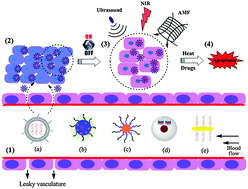Design of hybrid nanovehicles for remotely triggered drug release: an overview
Abstract
In the past few decades, various nanovehicles have been developed as drug delivery systems, in which inorganic and organic components are integrated within a nano-object. Upon the application of remote stimuli, e.g. alternating magnetic field, near infrared or ultrasound radiations, the release of guest molecules can be triggered in a quite controlled manner. Herein, we review different hybrid nanostructures which have already been reported for the remotely triggered release, such as those based on (1) host–guest conjugates, (2) core–corona nanoparticles, (3) polymer nanogels, (4) polymer micelles, (5) liposomes, (6) mesoporous silica particles and (7) hollow nanoparticles. Moreover, we also summarize six underlying mechanisms that govern such a kind of remotely triggered release behaviours: (1) enhanced diffusion and/or permeation, (2) thermo- or photo-labile bond cleavage, (3) fusion of phase-changed materials, (4) photo-induced isomerisation, (5) thermo-induced swelling/de-swelling of thermo-responsive polymers, and (6) destruction of the nanostructures. The ways in which different components are incorporated into an integrated hybrid nanostructure and how they contribute to the remotely triggered release behaviours are detailed.

- This article is part of the themed collections: 2015 Journal of Materials Chemistry B Hot Papers and JMC B Top Picks collection: Recent advances in drug delivery

 Please wait while we load your content...
Please wait while we load your content...